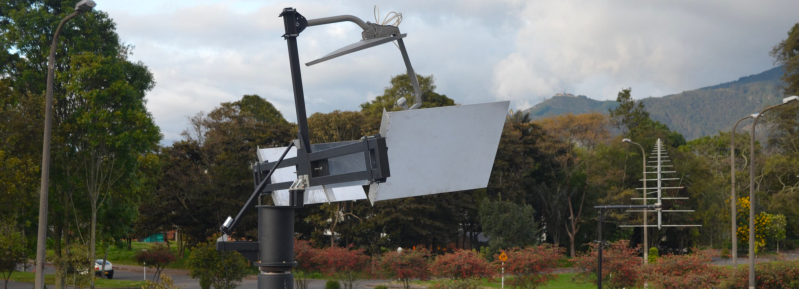Radio telescopes are one of the dark arts of science. Not only do you have to deal with RF wizardry, the photons you’re detecting are so far out of the normal human experience that you really don’t know what you’re looking at. It’s hard, but that’s the point — there’s a lot to learn with a radio telescope.
[alfazoOm]’s entry in the 2017 Hackaday Prize seeks to counteract a two-part problem: first, there is a dearth of educational radio interferometers in Latin America. Secondly, in Colombia, there’s only so much clear sky so radio astronomy is the preferred technique. Even though they’re so close to the equator, a lot of the northern stars can be seen as well. His interferometer, IMFR11GHz, answers both of those challenges.
IMFR11GHz is a Michelson interferometer, in which a light source is split into two beams, which are reflected by mirrors back to the detector. [alfazoOm] is basing his telescope off of the Stony Brook radio interferometer, though he is designing custom hardware that can position the dish in whatever direction the operator desires with an Alt-Az mount. The control system consists of an ESP32 microcontroller with an IMU and two stepper motors controlling azimuth and elevation. This is awesome citizen science, and a great entry in the Hackaday Prize.




















Interesting, I’ll have to read into more detail. I was reading about the NASA Inspire and JOVE projects recently and their design. I haven’t read about a Michelson Interferometer radio telescope. Seems as a Synthetic Aperture versus a Phased Array system is more accurate I’m thinking.
I guess just a really big driven disk and really small driver disk where the disk is a gear, pulley, sprocket or even more interesting is recently commenting regarding magnetic clutches, so magnetic gears maybe even. I started overthinking before reading. Time to read more. However, when thinking about a telescope… tracking systems are on the market and DIY’able.
There are lots of reasonably priced trackers for telescopes. The ones from sidereal technologies are very nice and will drive PM DC servo motors. There is also OnStep, a controller based around arduino/teensy that will control steppers or servos with step/dir interfaces.
Thanks for the references. Another one of the pre-teen hobbies that I eventually plan on getting back into post post secondary education and work experience. Even in the optical range or just outside of… the 3D printers modified to grind glass seem like an idea worth pondering to make large lenses. With other RF ranges, maybe be able to even print lenses with acetone Styrofoam or special polymer blends with maybe two dispensers for the conductive material.
Back to where we were, I do occasionally see on scopes with the trackers on shopgoodwill.com also for great prices.
I meant “…with scopes on the trackers…” above. Man, cooking dinner and going back and forth reading. Another, “edit” moment before I hit the POST COMMENT button. :-|)
I do love me some interference/synthetic aperture stuff. Though I think there are thousands of old sat dishes around that are bigger than this interferometer. I guess all the math and computation can be tested just fine with this short path.
Now I have to see why an IMU is needed.
Man, I read ya. I occasionally do “free satellite dish” Google searches specific to Craigslist where you use the syntax:
SEARCH TERM site:craigslist.com
I almost was going to go for a 12′ dish in Tuscon and there is an awesome 10′ dish with tall mast in Las Vegas area last I looked that didn’t go yet.